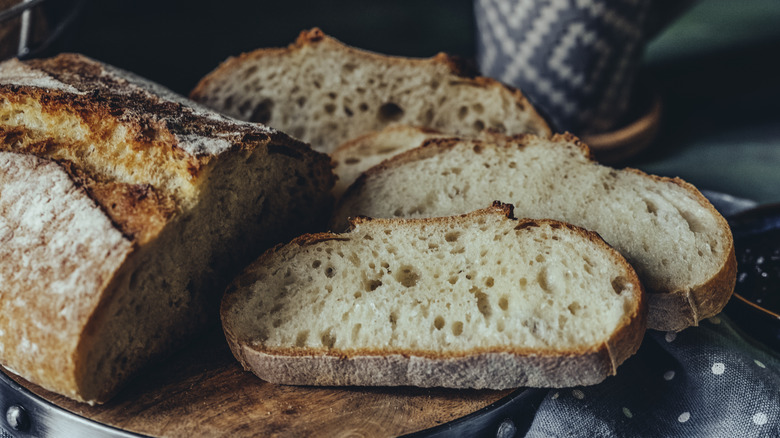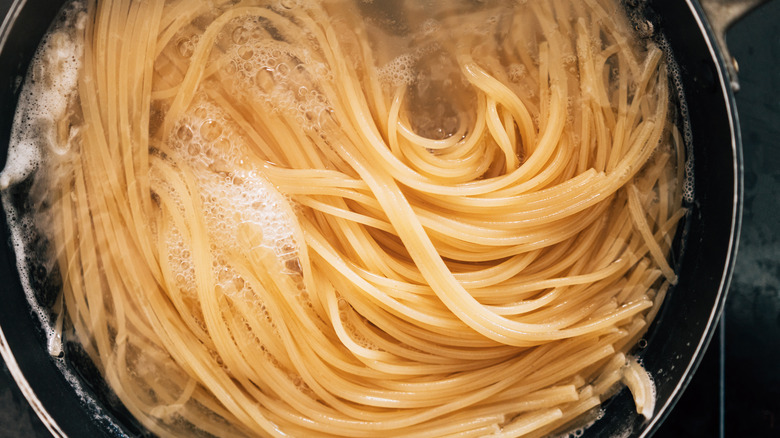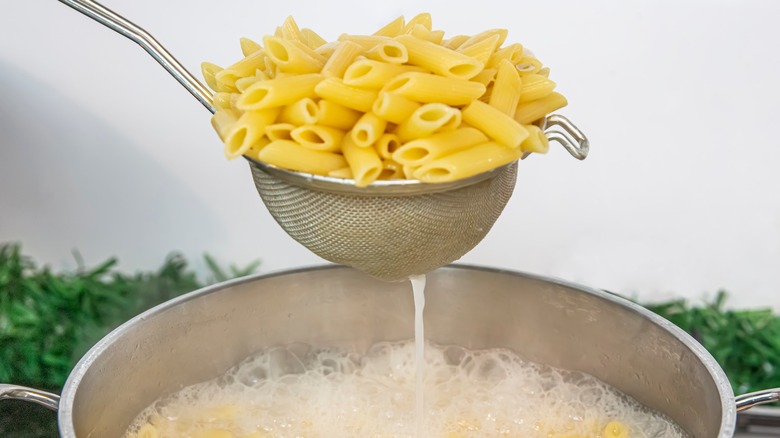Leftover Pasta Water Holds Unforetold Wonders For Homemade Bread
We've been told about the power that pasta water holds when it comes to successful, well, pasta dishes. Nearly all sauced pastas can benefit by the addition of a little of the water that the pasta has been cooked in, due to the presence of salt (which should always be added to pasta water) and the starches that accumulate in the water, which help coat each piece of pasta with sauce. While pasta water can be a mere suggestion in some recipes, it's absolutely vital in others, such as carbonara and cacio e pepe, where the only source of moisture in making the sauce is the pasta water itself.
But what if we told you that pasta water is one of those secret miracle elements that can be used in so much more than just pasta — namely, in making better bread? If you don't believe us, maybe you'll trust the word of beloved English home cook, television host, and author Nigella Lawson. In 2020, she explained on Twitter that pasta water improve the texture and rise of homemade bread. She's not alone in her claim, either. Others suggest that substituting pasta water for plain water in bread recipes will result in better browning, crisper crust, and heavenly chewiness.
If you're a carb fanatic who bakes homemade bread loaves and considers pasta a weekly dinner staple, don't dump that water down the drain.
Getting technical
Most standard bread recipes begin with combining warm water with yeast and sugar. This activates the yeast and prepares it for doing its job when the rest of the ingredients are added.
Sugar is added to feed the yeast, making it produce carbon dioxide, which essentially makes bread rise. Starch feeds yeast, and it also interacts with gluten. By feeding the yeast, the bread dough will rise beautifully and create a wonderful texture, thanks to the carbon dioxide produced. The starch helps the gluten set, keeping the bread from collapsing when it's removed from the oven.
So, where does this starch come from in pasta water? The pasta, of course. When boiled in water, pasta releases its starch. And when it's combined with the hot water, the starch expands and gelatinizes. This is why adding pasta water to sauced pasta helps with coating and thickening. And when that water is used in bread-making, you have extra starch, which makes discernibly better loaves.
The method to the madness
Making this magic happen in bread recipes couldn't be easier. All you need to do is substitute the exact amount of pasta water for the plain water your recipe calls for. (It still needs to be warm, so heat it accordingly.)
The one thing you'll need to be mindful of is how salty your pasta water is, as most bread recipes call for salt. If your water is very salty, you'll need to adjust the amount of extra salt or eliminate it completely. But if it's not salty at all, you can probably get away with adding the salt as noted.
So, how do you save pasta water? For starters, stop pouring your cooked pasta and hot water through a colander over the sink, and start using a spider utensil or small colander to fish the pasta out of the water itself. When the water cools, you can pour a desired amount into jars for refrigerating or into ice cube trays for freezing. As a bonus, you don't need to stop at using this water for bread. Pasta water is a great substitute for stock in soups and stews, you can use it to steam your vegetables, and it's great for making rice and cooking dried beans.



